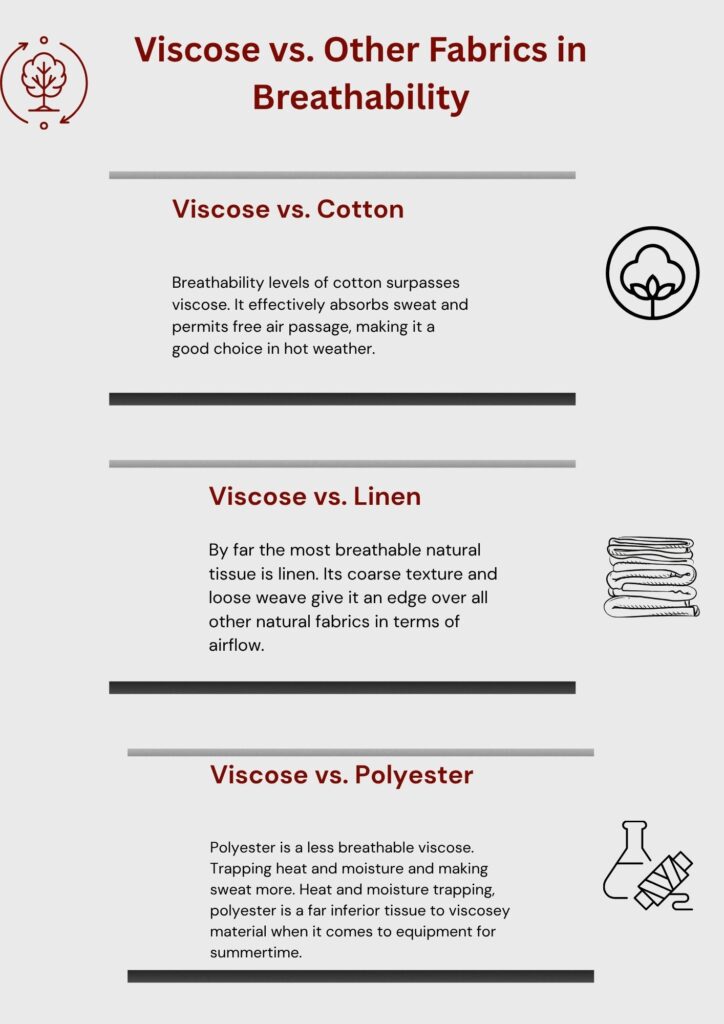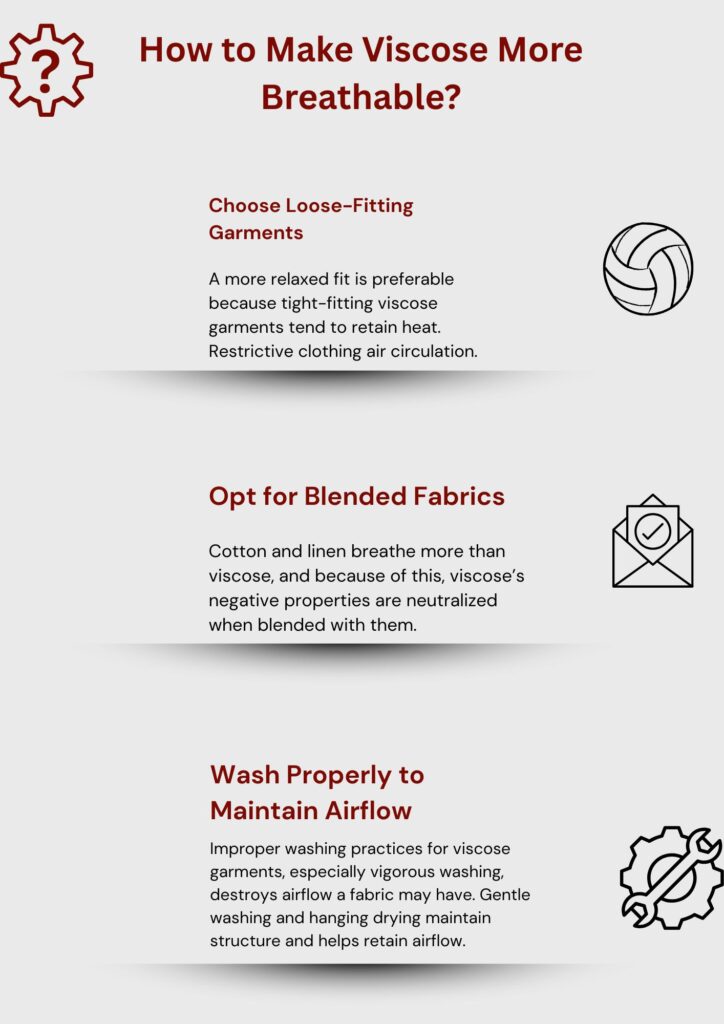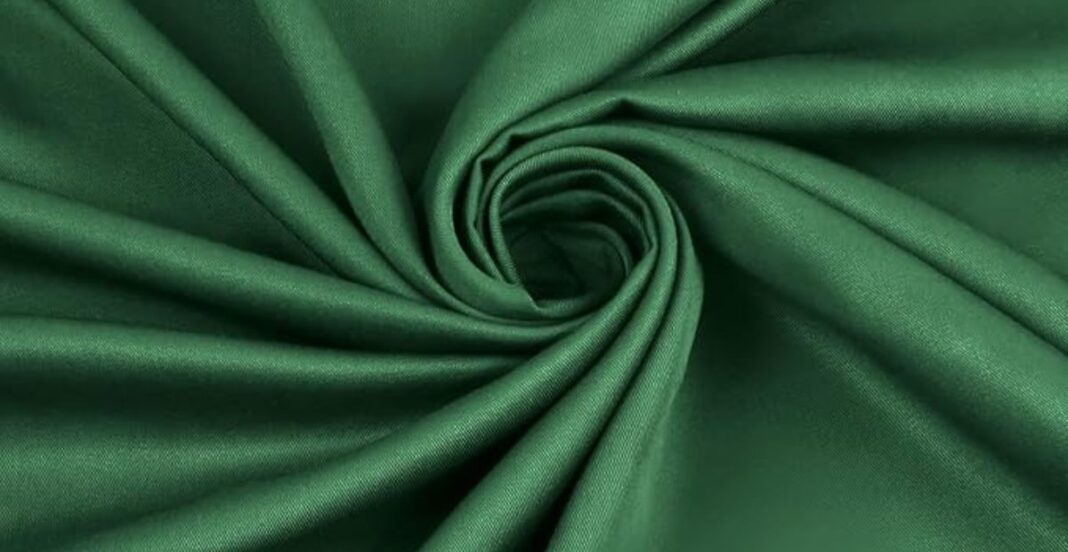Introduction
Also referred to as rayon, viscose is categorised as a semi-synthetic fibre derived from natural products. It offers a cross between synthetic and natural fabrics, providing silky texture alongside a great drape. Viscose is popular for clothing and home textiles because of its soft texture and affordable price.
In addition to clothing, home textiles like lightweight curtains and flowy dresses have also gained the attention of the public due to the soft and silky feel viscose provides. However, there still remains a question if viscose is breathable enough for any kind of summer wear.
This article will explore every aspect about viscose to determine if it is the best choice for the hot humid weather.
What is Viscose?
Viscose is produced by the chemical treatment of wood pulp which is usually derived from bamboo, pine or beech. The resulting solution is spun into fibers, and woven to make fabric. The process of starting with natural cellulose and undergoing chemical processing qualifies the material as semi-synthetic.
Viscose fabrics are softer than cotton, have a sheen likened to silk. Air permeable plant-based fabrics like cotton and linen are natural fabrics. On the other hand, man made fabrics like polyesters are entirely synthetic and mostly trap heat.
Viscose rests somewhere in between those two extremes. While it imitates the breathability of natural fabrics, it lacks some airy goodness offered by the synthetic alternatives.
Is Viscose Breathable? (Core Answer)
Yes, Viscose Is Breathable but with Limits
The answer to the query “Is Viscose Breathable?” would be yes, but it is certainly not the best option out there. While Viscose is not the best breathable fabric, it does allow air to pass through synthetics more easily than most. But, as compared to cotton and linen, it’s less breathable.
The reasons for breathability for viscose include the following:
- Moisture Management: Viscose’s capacity to absorb moisture helps with sweat absorption but makes it sticky.
- Lightweight Structure: Because of its soft fabric composition, it provides a cool and light sensation against the skin.
- Airy Weave: Loosely woven viscose has better airflow than polyester and other tightly woven synthetic materials.
To conclude, Viscose may help maintain thermal comfort in warm weather, but it is not suitable for extremely humid or hot environments.
Factors Affecting Viscose Breathability
Fabric Blend: Pure Viscose vs. Blended Fabrics
The type of blended fabrics can influence the breathability level of viscose. Pure viscose is usually more breathable than blends of polyester. However, blends of cotton or linen into viscose are an improvement since they increase airflow and softness, too.
However, cotton viscose blends with spandex or polyester becomes less breathable. Always check the label while purchasing clothes for warm weather.
Weave Type: Knit vs. Woven
Knit vs woven weaves differ in the way air can flow through fabric. Knit viscose, for example, is stretchier and warmer, while loosely woven viscose is cooler due to better air circulation.
Light, open weaves are better for summer clothing since they provide freer escape for heat and sweat.
Fabric Thickness: Thin Viscose Is More Breathable
Shops usually sell summer clothes made out of thin, single-layered viscose. This is effective since thinner fabrics are proven to be more breathable. On the other hand, thick or layered viscose can be heavy and trap heat.
Viscose vs. Other Fabrics in Breathability

Viscose vs. Cotton
Breathability levels of cotton surpasses viscose. It effectively absorbs sweat and permits free air passage, making it a good choice in hot weather. On the other hand, cotton becomes heavy when wet whereas, viscose maintains a lightweight feel.
Viscose vs. Linen
By far the most breathable natural tissue is linen. Its coarse texture and loose weave give it an edge over all other natural fabrics in terms of airflow. Drawback is that while linen has better airflow, smoothness viscose outperforms linen.
Viscose vs. Polyester
Polyester is a less breathable viscose. Trapping heat and moisture and making sweat more. Heat and moisture trapping, polyester is a far inferior tissue to viscosey material when it comes to equipment for summertime.
Viscose vs. Bamboo Viscose
Another form of rayon is bamboo viscose, however, this is produced from bamboo pulp specifically. It is more breathable and antibacterial, making it excellent for summer as well as for sensitive skin.
Best Uses of Viscose for Breathability
Summer Dresses, Blouses, and Skirts
Dresses, blouses, and skirts can be made from viscose as it is ideal for summer wear. It breathes well. Moreover, softer, and drapes nicely which adds a touch of elegance. Go for the loose-fitting and flowy styles.
Lightweight Scarves and Activewear
Scarves and light exercise wear, can be made from viscose because it adds a cooling sensation. Although not suitable for rigorous exercise, it is fine for walking and serves as a good layering piece.
Bedding: Viscose Sheets for Hot Sleepers
Bed sheets made from viscose are becoming increasingly popular, especially for hot sleepers. During warm nights, the fabric remains cool against the body and absorbs sweat.
Pros and Cons of Viscose for Breathability
Pros
- Softness: Provides a luxurious and pampering touch to the skin.
- Moisture Absorption: Absorbs sweat, providing a cool feeling at first.
- Good Drape: Moves nicely with the body and allows some ventilation.
- More Breathable Than Polyester: Outperforms polyester as a warm-weather synthetic alternative.
Cons
- Wrinkles Easily: Frequent ironing is required.
- Can Retain Heat in Humidity: May feel clammy when moisture cannot evaporate.
- Delicate Fabric: Prone to damage during prolonged wear and/or physical activity.
How to Make Viscose More Breathable?

Choose Loose-Fitting Garments
A more relaxed fit is preferable because tight-fitting viscose garments tend to retain heat. Restrictive clothing air circulation.
Opt for Blended Fabrics (Viscose + Cotton/Linen)
Cotton and linen breathe more than viscose, and because of this, viscose’s negative properties are neutralized when blended with them. These blends also mitigate moisture-stickiness during humid weather.
Wash Properly to Maintain Airflow
Improper washing practices for viscose garments, especially vigorous washing, destroys airflow a fabric may have. Gentle washing and hanging drying maintain structure and helps retain airflow.
Common Misconceptions About Viscose Breathability
“Viscose Is Synthetic, So It’s Not Breathable”
Considered fully synthetic, many ignore that viscose is semi-synthetic, made from natural wood pulp. Unlike nylon or polyester, viscose behaves differently from purely synthetic fabrics.
“All Viscose Feels the Same”
There is a lot of variation among different types of viscose, however. Some are light while others are heavy or mixed with less breathable fibers. Always check the fabric type before purchasing.
Conclusion
So, is viscose breathable? Yes, but with some conditions. Compared to nylon or polyester, viscose does breathe better; however, it still does not reach the airflow levels provided by cotton or linen.
With the right choices, viscose can make for a great summer fabric. Pick garments made of thin weaves, loose cuts, and blends to make them with breathable materials. It is great for fashion forward yet comfortable outfits during mild to warm weather.
For extreme heat or humidity, look at alternatives like linen, or bamboo viscose. These fabrics outperform viscose’s breathability levels.
FAQs
Comparatively to synthetic materials such as polyester, viscose is breathable. It works well for warm climates because it offers some airflow and absorbs moisture, though not as well as natural fabrics like cotton or linen.
It works well during hot weather if the fabric is lightweight and loosely woven since it is cool and soft on the skin. Viscose does not perform well in humid climates and tends to trap moisture, making the fabric clingy. Wearing loose-fitting garments will help as well as blends that contain cotton.
Viscose does not outperform cotton in this regard. It is common knowledge that cotton is more breathable as its fibers permit more airflow and wick water. While softer and more luxurious, viscose does not dry as fast as other fabrics, thus for extreme heat, cotton is a better option.


